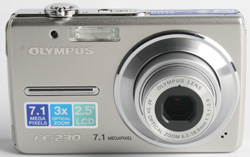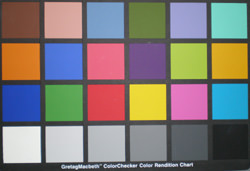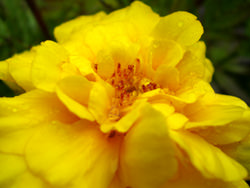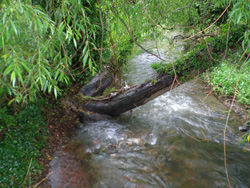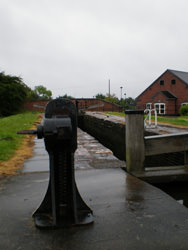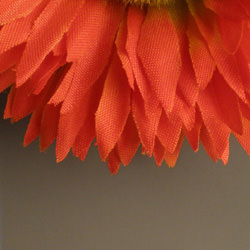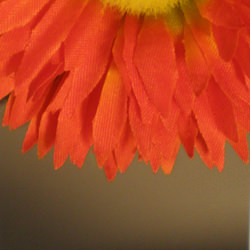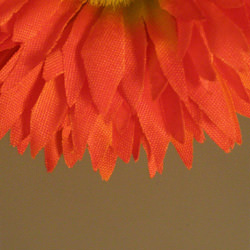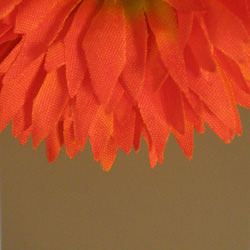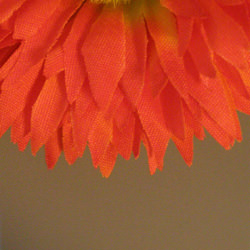The FE-230 is a small, cheap compact with a good build quality and reasonable specification in a slim casing.
- Sensor: CCD – 7.1Mp
- Image Size: 3072 x 2304 Pixels
- Lens: 38-114mm f/3.1-5.9 (3x zoom)
- Focus: TTL Autofocus – 5cm Macro
- Exposure: Program AE / 18 Scene
- Metering : iESP
- Monitor: 2.5in TFT LCD
- Movie Mode: Yes
- Storage: 20Mb Internal, xD Card
- Batteries: Lith-Ion – LI-42B
- AC Adaptor: No
- Video Output: Yes
- Size/Weight: 90x55x16mm – 105g
- Transfer: USB
The Olympus FE-230 costs around £129 and is comparable with the Casio EX Z70 at £149 with 7.2Mp, 3x optical zoom and 10cm macro or the Kodak V803 at £149.99 with 8.32Mp, 3x optical zoom and 5cm macro feature. All cameras are similar in specification, so it could just fall to personal preference.
Olympus FE-230 Modes and features
The camera is attractive to look at and I was pleased to see a well laid out camera. The shutter and power buttons are situated on the top of the camera with the zoom wrapped around the shutter release. On the back, two buttons are above the 2.5in screen and they are to flick between taking pictures and looking at them. A light is in the middle of them which will flash when 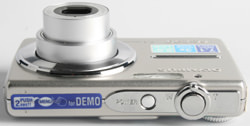 downloading images to the card or internal memory. The mode dial has the options of Auto, Video, Guide which gives information on what setting to put the camera on for particular pictures, Scene which will set the camera to certain types of photography and then the most commonly used features of Night portrait, Landscape, Portrait and Anti-blur which seems a little unusual giving it it’s own designation as it could be input as an automatic feature on portraits or night portraits, for instance.
downloading images to the card or internal memory. The mode dial has the options of Auto, Video, Guide which gives information on what setting to put the camera on for particular pictures, Scene which will set the camera to certain types of photography and then the most commonly used features of Night portrait, Landscape, Portrait and Anti-blur which seems a little unusual giving it it’s own designation as it could be input as an automatic feature on portraits or night portraits, for instance.
The Scenes available are Sport, Indoor, Candle, Self portrait, Sunset, Fireworks, Behind glass, Cuisine, Documents, Auction, Under water Wide 1, Under water Wide 2 and Under water macro. Each of the under water modes are different, number two fixes the focus, for example and each mode has an amusing warning that an under water casing is required when submerging the camera.
The Menu button is at the bottom of the camera and has a concave design which is nice, but can be awkward to operate like in times of speed. The menu can be navigated using the pad wrapped around the OK button which also doubles up as a Macro button, Flash options, Self timer and Exposure compensation button. The lay out of the menu does not comply with the usual rules of design and is a refreshing change as it makes you think about what you want to do. The Image quality option is preset as the first choice to change. Scrolling around the thumbnail icons can allow changes to the Set up, Picture & Sound recording which records 4 seconds of audio after the images has been taken, Silent mode to mute all noises which is a good idea for wildlife 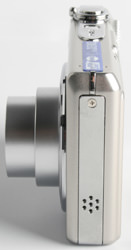 photography and Reset. The Scene button will only be highlighted when in Scene mode on the dial and the panorama icon will only highlight when an xD picture card is inserted. The set up allows changes to be made to the core features of the camera and three pages are available for quick leaps to the desired setting or the pages will automatically scroll through all three. The first option is to Format the card followed by language setting, Pixel mapping which is like a calibration setting that only needs to be performed maybe once a year or so, the next button allows the power to be switched on by using the Camera or playback buttons above the screen, Screen brightness, Beep volume when pressing buttons, Action volume, Shutter sound volume and Master volume. The last page has only two options which are Time & date and Video output to change from PAL to NTSC.
photography and Reset. The Scene button will only be highlighted when in Scene mode on the dial and the panorama icon will only highlight when an xD picture card is inserted. The set up allows changes to be made to the core features of the camera and three pages are available for quick leaps to the desired setting or the pages will automatically scroll through all three. The first option is to Format the card followed by language setting, Pixel mapping which is like a calibration setting that only needs to be performed maybe once a year or so, the next button allows the power to be switched on by using the Camera or playback buttons above the screen, Screen brightness, Beep volume when pressing buttons, Action volume, Shutter sound volume and Master volume. The last page has only two options which are Time & date and Video output to change from PAL to NTSC.
Playback menu has a series of nice little features too. Options available are a Slideshow, Resizing the images, Print order for direct printing, My favourites where upto nine images can be saved as favourites. These images are protected even against formatting the card. The Set up is also available and DIS edit which will amend an image with image blur, Erase and the Silent mode.
Olympus FE-230 Build quality
At first glance, the FE-230 appears to be made entirely from metal, but on closer inspection it turns out to be a plastic casing with a very good metal effect coating. The lens is a little wobbly but only when manipulated manually and is no severe detriment as it doesn’t deter from the overall feel of the camera. It is light and balanced which is another indication of a plastic body. The camera comes with 20Mb of internal memory and can take a maximum size card of 2Gb.
The xD card goes into the same slot as the battery, but the battery is snared in using a spring loaded catch and the card has to be pushed in to eject so no fear of anything falling out accidentally.
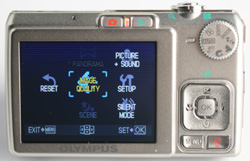 Olympus FE-230 Flash options
Olympus FE-230 Flash options
Four flash options are available and these are Auto, Red-eye reduction, Flash on all time and Flash off all the time. No Fill in flash or slow sync. Seems that Olympus don’t think the users of the FE-230 will be bothered about these settings. Frankly, I think they got that right.
The distance is 0.2 – 3.8m at wide angle and 0.6 – 2.0m at telephoto which is just within acceptable parameters but is by no means excelling.
Olympus FE-230 Performance
The camera managed to take three images in ten seconds but doesn’t have a continuous shooting mode, so focusing and metering had to be redone each time. The download time is terribly slow and moving through the playback area to delete images can take a long time if images are on the top resolution. The delete button also takes ages and can get frustrating.
Focusing takes approximately a second so is not the fastest but the start up time is about the same which is quite good. Metering is standard TTL centre weighted with no options to change to Matrix or Spot, but users of this type of machine will not be so bothered.
The low light image gave a slow shutter speed so I used the bridge I was stood on to steady the camera. The water is slightly blurred as it runs under the canopy of trees, which is good for a sense of movement. The rest of the scene is well exposed considering the horrible day. The macro image was nicely coloured and using the super macro can get in nice and close. I do not see the point of the normal macro other than the availablility of zoom, but I am sure Olympus have a reason for it. The portrait shot softened the features and muted the colours which is a little unusual as most cameras boost the colours which, ironically, is exactly what the auto mode does. So if you like having skin tones warmed up when taking portraits, don’t choose the portrait mode.
Olympus FE-230 Noise test
I had fun with this as the FE-230 doesn’t have an ISO setting so I had to manually move the light further away from the subject to reduce the light available and increase the ISO rating. I only got five ISO changes with the camera several feet away.
ISO80 has a nice smooth finish with lots of detail in the petals and a nice colour reproduction. ISO125 makes the grey card go more off colour thanks to the wonderful lack of White balance override, but noise remains absent and the petals ar emore orange. ISO160 has little difference from ISO125 with the exception of a little more noise on the grey card. ISO200 and ISO250 also have little change except a mild increase in noise. The ratings are so close together it is difficult to give a fair appraisal.
Olympus FE-230 Verdict
I have mixed feelings about the FE-230. It is a nice design and has a good layout. The lack of ISO ratings annoys me as does the lack of White balance overrides. The picture results are good for the price, but I have seen cheaper models with more features.
The FE-230 is aimed at the happy snapper and bows to the requirements of that type of consumer. It is easy to use, attractive to look at and is built to a decent standard. If you get this camera expecting miracles, you will be sorely disappointed, but it will give good results for a cheap compact, which is exactly what it is.
FEATURES![]()
PERFORMANCE![]()
HANDLING![]()
OVERALL![]()
The Olympus FE-230 costs about £129 and is available from the ePHOTOzine shop here.
